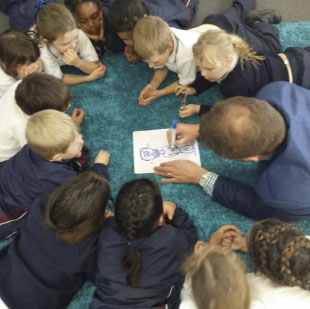Download a printable copy of this article (PDF 285KB)

- Chunking time, over time, impacts classroom climate
and behaviours in positive ways. - Use time chunks to maximise engagement and keep on track.
- Chunk time into the smallest possible pieces.
- Remember to chunk time as deliberately as we would the academic program.
- Not knowing an end time breeds distraction.
Many years ago I was into a variety of different sports. When you’re young sport is a great way of connecting with others and is a wonderful distraction from social and academic pressures. I tried my hand at the usuals from football to cricket through to golf, tenpin bowling, darts and basketball. Being blessed with modest abilities but a 6’5” frame it was in basketball that I found I had something to offer the team.
“My favourite things in life don’t cost money. It’s really clear that the most precious resource we all have is time.”
– Steve Jobs
This was until one fateful Friday evening playing F Grade, I hauled down a rebound and as I looked to pass off an opponent running towards me fell over. His shoulder rammed into the side of my left knee and a sharp clapping sound followed by an excruciating pain told me this wasn’t good. A confirmed diagnosis of a snapped anterior cruciate ligament meant I was out of the game for the next 12 months.
During my rehabilitation, the doctor warned me once or twice to take care of my good knee. As I started to walk again, it took the brunt as my limp eased pressure on the injured joint. It seemed odd to watch out for the healthy knee, when the injured one clearly needed the treatment, but more odd was his warning about Cinema Syndrome. I thought him just a little bit … weird.
I went to the cinema with my wife one evening about six months into the rehab to see Titanic. I dutifully agreed and sat down armed with enough popcorn to cater for a circus. As the movie went on, I noticed my good knee getting tight, then achy and then downright sore. I also noticed that despite having already gone more than 100 minutes in the one chair with an exhausted wheelie bin sized popcorn container on the seat next to me this movie hadn’t nearly finished yet.
How long would I be trapped here?! I began to fidget, to stretch my legs awkwardly without kicking those around me, to check my watch, to become genuinely annoyed with Jack and Rose on the screen. “Get on with it! We know how this ends!” It seemed to me that the Titanic took about six onscreen hours to actually sink and my knee was killing me! If only I’d known how long this thing was in the first place!
This is how it often is in our classrooms. Teachers are adept at chunking and sequencing academic learning, yet we forget to chunk the time that students will be required to listen to instruction or to sustain effort. In much the same way that adults fidget when we don’t know how long the movie will be, students will resist our instruction if they have no idea how long they’ll be required to listen, or to sustain silence, or to work collaboratively.
Declaring my intentions about time expectations in the classroom has become my obsession. This healthy obsession has come about because it works so well, for a couple of reasons:
- When we tell students that we’ll only be speaking for five minutes, they actually brace themselves and settle in for a period of time with which they are familiar and more than capable of sustaining attention for. When we don’t, at approximately three minutes, most of the males in the room are wondering when this will end and have begun to stare at others, to stare out the window, to distract others or to at least mentally go to another place … with footballs.
- It keeps us on track. When we declare time expectations, we are less likely to fall into the trap of two significant teacher vices. The first is speech making, a lust for our own voices that can lead us to talk about a topic for ever … and ever … and seemingly ever. Secondly, many of us have tendency to high levels of distraction. The introduction of current and interesting topics by students during explicit instruction can be tough to resist. But if we have declared that this is only five minutes of instruction, we are likely to stick to the point.
Give a little thought to your own responses to time. How comfortable are you with the late plane, the boring PD presenter, the drivel on late night television or sitting through your partner’s favourite activity that is clearly not yours? Time matters to us all, and especially to our students, whose concentration spans are yet to develop to our level.
The chunking of time isn’t just a tool for higher levels of engagement and student productivity. Over time, it becomes incredibly difficult for students to distract others, to bully or to demonstrate negative behavioural patterns while they are immersed in a pedagogical pattern that so fosters and scaffolds success. The resultant feelings of achievement and connection can have a profound impact on classroom climate and the positive behaviours that are normalised within that climate.
Chunking time may be the key to unlocking an exponential improvement in the engagement of our students. Isn’t it at least time that we found out?








